#skara aesthetics
Text
I put a Skara avatar in my AR Studio, keeping with the design/hc she has a prosthetic leg.






#Skara#avatars#skara avatars#skara aesthetics#The Owl House#prosthetics#black female cartoon characters#cartoon fanart#skara fanart#Nesha Fanart#Nesha Does Things#AR Emoji Studio#black witch#cartoon witch#white hair#prosthetic leg#This is a Skara Appreciation Blog
15 notes
·
View notes
Text
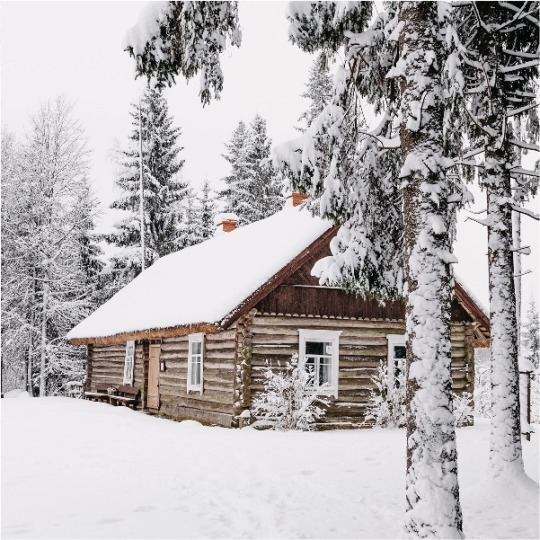







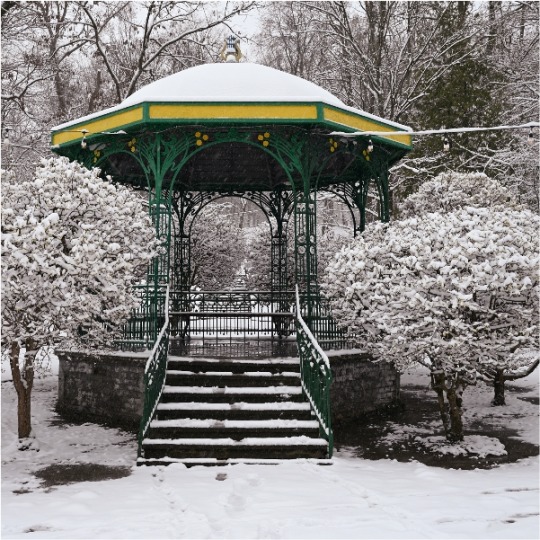
~ books read in 2023 ~
#38: Juniper's Christmas by Eoin Colfer
I'm sure you know Santa's story. Everyone knows it, but since it's one of the greatest tragedies of all time I shall summarize here before we move on to the story of a girl from London who would track down Santa Claus when he hid himself away from the world.
Rating: 5/5
#juniper's christmas#eoin colfer#2023 reading list#books#book aesthetic#book moodboard#middle grade books#fiction#christmas#family#santa claus#magic#a reindeer named skara
2 notes
·
View notes
Text
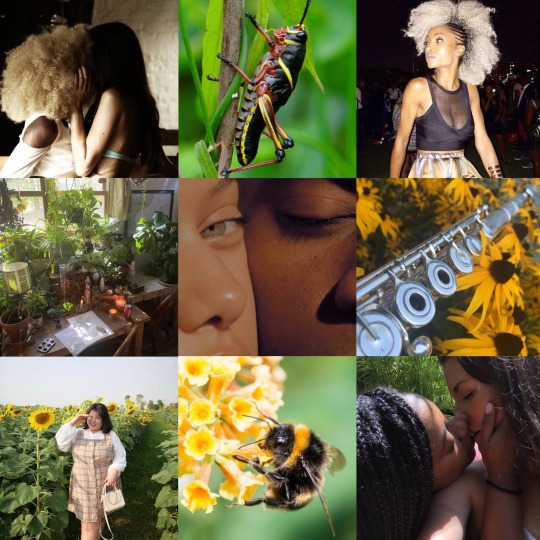
Skarlow moodboard 🐝💖🦗
#toh#the owl house#skarlow#skara#skara toh#toh skara#Willow park#toh Willow#look I’m 100% aroace Willow bc my Willow was but this ship is so cute#toh moodboard#toh aesthetic#the owl house moodboard#the owl house aesthetic#Willow park moodboard#skarlow moodboard#skara moodboard#Willow park aesthetic#skara aesthetic#moodboard#my moodboards#bugs
28 notes
·
View notes
Text
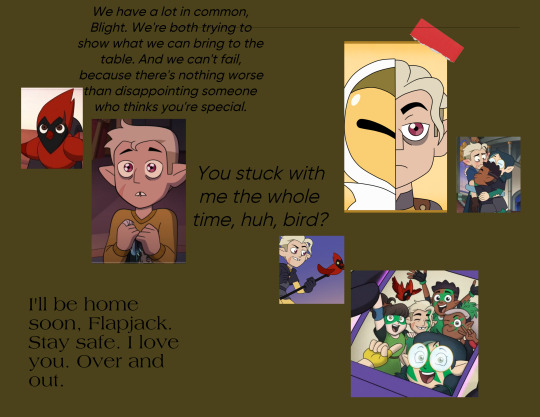
I just finished the season 3 episode and decided that I had to make a Hunter mood board, please credit me if you repost. The photos show him evolving across the 3 seasons.
<<<< Amity's first mood board
<<<< Amity's second mood board
#the owl house#aesthetic moodboard#toh hunter#toh willow#toh gus#toh skara#toh flapjack#golden guard#toh golden guard#toh season two#toh season three#tohspoilers
9 notes
·
View notes
Text
The Monster House Stories (Owl House x Monster Hunter):
(Quick disclaimer, Demons/Beasts/Palisman will be monsters themselves, Witches have monster partners)
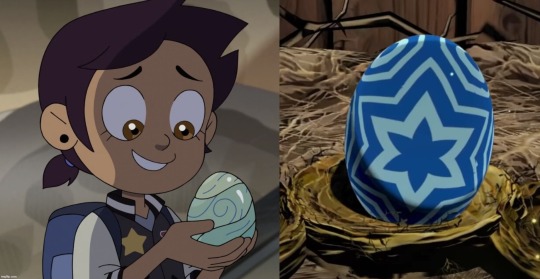
Luz Noceda has an unhatched Egg.

Amity Blight has a Nargacuga.
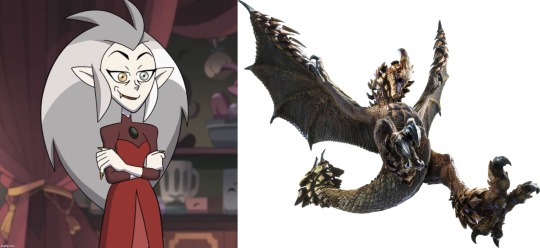
Edalyne Clawthorne’s Owl Beast form is replaced by Seregios (Malfestio was too surface level)
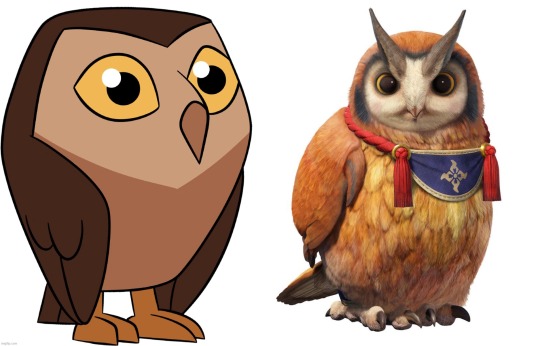
OwlBert is a Cahoot.

King is a baby Lao Shan Lung.

Augustus Porter has a Qurupeco.
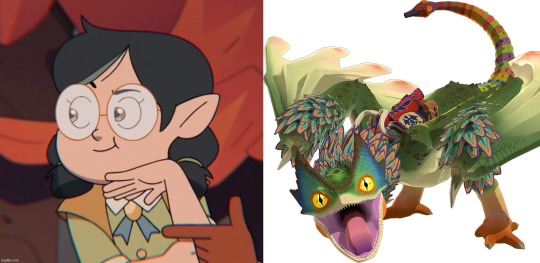
Willow Park has Pukei-Pukei. (And perhaps has an insect glaive for Clover)
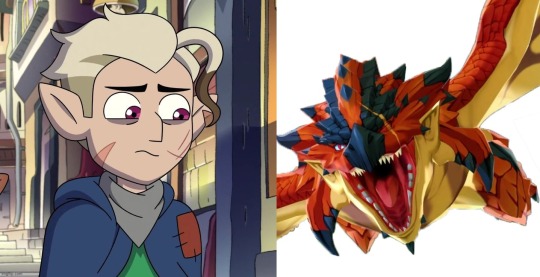
Hunter has a scarred Rathalos,(P.S. It’s Flapjack)

Hooty is Khezu.
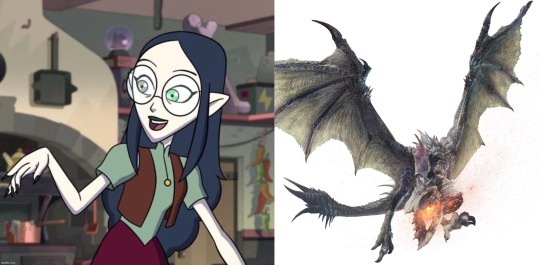
Lilith Clawthorne has a Yian Garuga. (The Raven Beast form is a much larger one)

Edric Blight has a Paolumu.
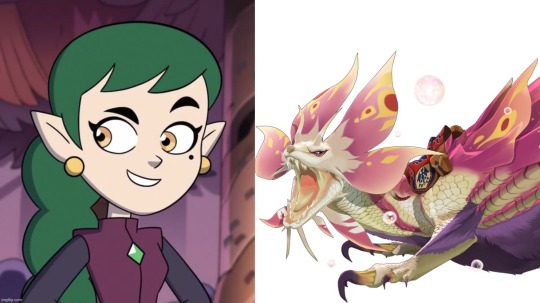
Emira Blight has a Mizutsune.
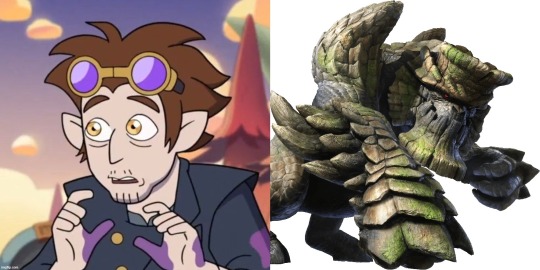
Adalor Blight has a Garangolm.

Odalia Blight has a Velkhana.
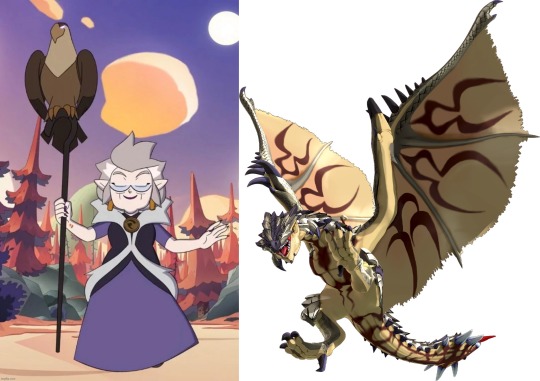
Gwyndolin Clawthorne has a Silver Rathalos.

Dell Clawthorne has a Golden Rathian.
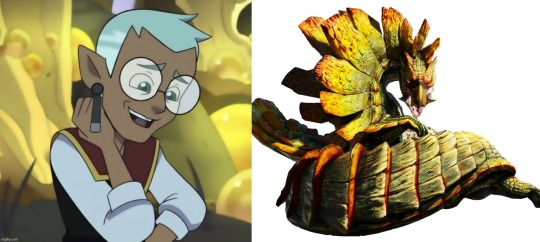
Raine Whispers has a Najarala.
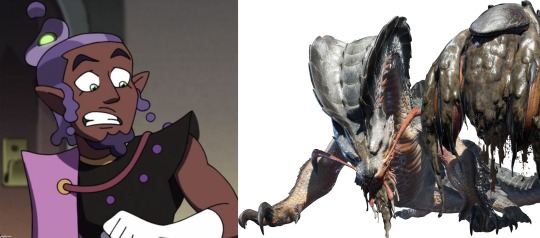
Darius has a Aldranon.

Boscha has an Odogaron. (Or is one, there isn’t much of difference)

Viney has a Yian Kut Ku.

Jerbo has Ash Kecha Wacha.
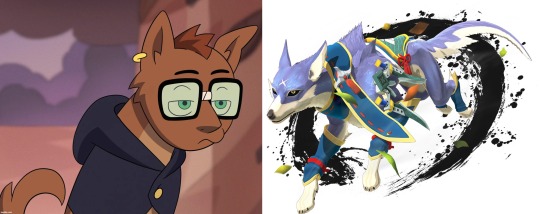
Barcus is a Palumute.
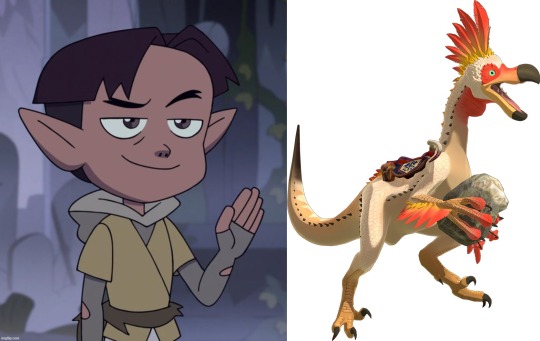
Mattholomule has a Kula Ya Ku.
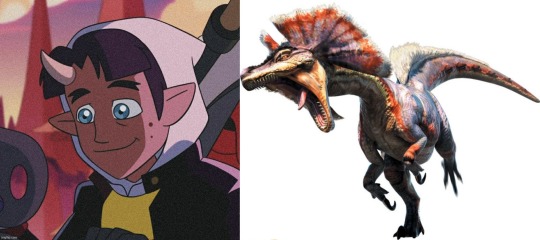
Steve has a Great Jaggia. (but since they also call Seregios “Steve,” feel free to use that)
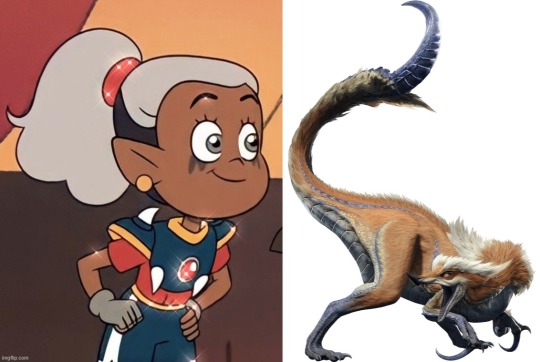
Skara has a Great Izuchi.

Bria has a Barroth.

Vee is a Somnacanth...

...or Barlagual. (First for aesthetic, second for it’s bloodsucking and power-stealing ability)
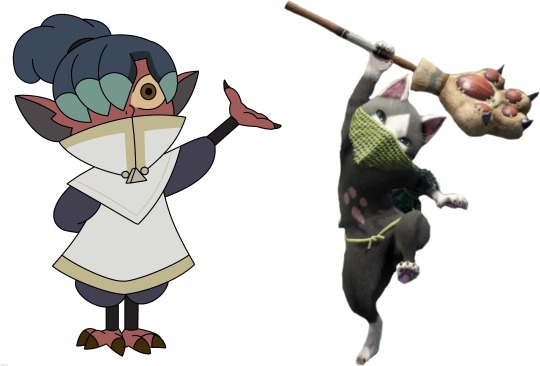
Kikimora is a Melynx.
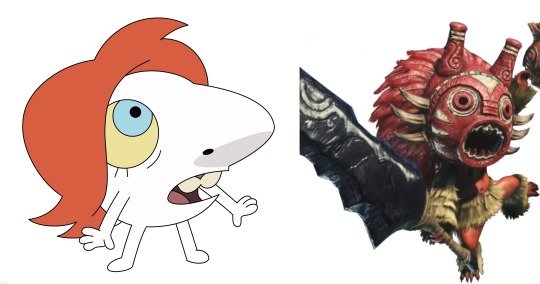
Tiny Nose is a Gajalaka.

Warden Wrath is an Anjanath.
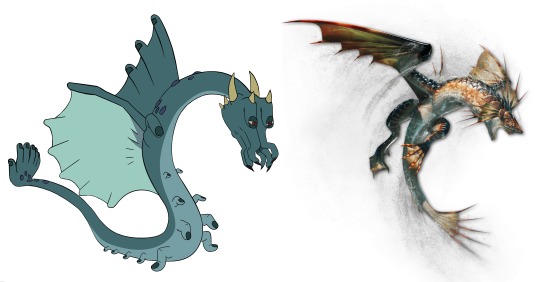
Princess is Plesioth.

The SlitherBeast is Blangonga.
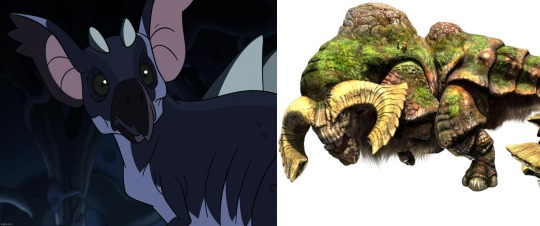
StoneSleeper is a Duramboros.

Selkidomus is a Royal Ludroth.
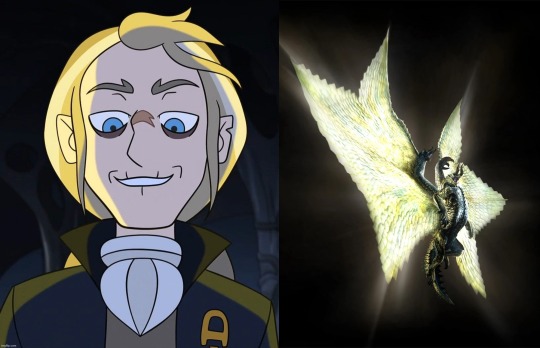
Belos was human, but now is Shagaru Magala.

Young Belos is Gore Magala. (I don’t know when he changed)

Devolves into Chaotic Gore Magala due to his curse.

The Collector is a Xeno'Jiiva.
#the owl house#owl house#toh#monster hunter#mh#monster hunter stories wings of ruin#monster hunter stories 2#monster hunter stories#luz noceda#vee noceda#amity blight#edalyn clawthorne#eda clawthorne#eda the owl lady#lilith clawthorne#toh hooty#king clawthorne#toh king#gus porter#augustus porter#willow park#toh hunter#mattholomule#edric blight#emira blight#alador blight#odalia blight#gwyndolin clawthorne#dell clawthorne#emperor belos
216 notes
·
View notes
Text
Official Trailer Plot Analysis!
All right! I think I figured the general plot from here!
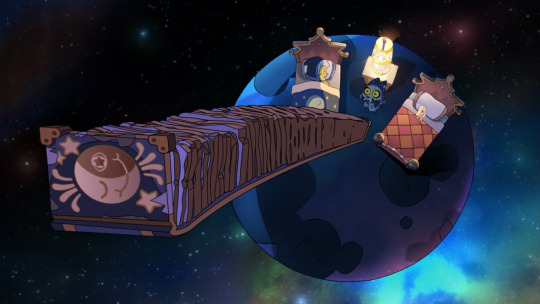
The Collector has King read him a bedtime story, our way of exposition in a short timeframe like the montage from Thanks to Them! We learn that the Collectors preserve life, probably in scrolls, and destroy all who oppose them. Obviously the Titans did this and both sides were wiped out, with our Collector and King as orphans of war. Our Collector has scribbled in his book that he’d prefer to play with everyone as toys, rather than just leave them lying around like with the Owl Beast. Perhaps King’s dad saw this and spared the Collector via mere imprisonment, only to be killed before he could free him afterwards.
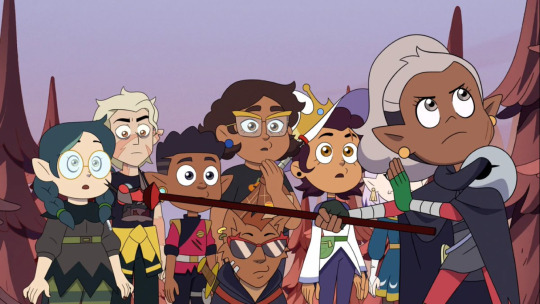
We cut to Luz and co., who stumble across the Owl House since we last saw it in O Titan, Where Art Thou! The isles seems just deserted but intact… Eventually they head to Bonesborough, which LOOKS normal but empty, until they reunite with Barcus and Skara! The two explain what’s happened and how Hexside is a place for everyone to hide…

BUT WUH-OH! The Collector shows up, converting the place to their own aesthetic! Hunter protects Willow and our kids escape, and King and Luz probably see each other for the first time in forever!

The kids are led to Hexside where Mattholomule and the others are. In order to infiltrate the Collector’s palace above the Titan’s skull (the area now renovated to their liking), Luz remembers the glyph combo Philip used to teleport there. They search through her memories using the magic tweezers to copy it down, and Camila potentially sees she was a fear of Luz’s at one point and reflects…

Meanwhile, we see Belos finding his old cave hideaway from when he was Philip. After feasting on a magical butterfly to refuel, he’s likely got his own backups to handle with the Collector, and possibly using the same glyph combo from before! Maybe he forgot and needs to check other notes that weren’t his mouse-devoured journal?

The Collector, alas, makes it to Hexside and turns the adults into puppets. The kids escape through an underground route inside the Detention Pit monster, but come into conflict, possibly against the Titan Trappers and/or puppets. Note that Luz is using a glyph, so she hasn’t unlocked her staff yet probably.

Our kids eventually make it outside, and at this point Luz’s egg hatches, possibly due to Camila seeing the Grom memory and talking to Luz about how she’s accepted no matter what home she chooses. The excited kids practice a brief session of Flyer Derby so Luz can get the hang of things… The area might be near where Belos is currently hidden in his cave. Maybe the kids realize they don’t need the glyph combo because they can just fly, and mayhaps Hunter and Camila got Skara and someone else’s staff to do so.

Hooty is turned into a puppet while Lilith mourns, possibly on a rescue mission for King! Either way he ends up with King as a puppet, while Eda is confronted by the Coven Heads (sans Terra) who have been transformed! Was she imprisoned as the Owl Beast, only for King to bring her back to normal with his squeal of rage? Or was King put in timeout by the Collector?

Mother and son make it outside, and this is where the Collector confronts Eda, prompting her Harpy mode to become more Owl Beast. We can guess this happens at the end because King’s scar is gone, possibly due to his powers emerging?
#the owl house#luz noceda#king clawthorne#the owl house collector#emperor belos#philip wittebane#eda clawthorne#edalyn clawthorne#analysis#speculation#theory
95 notes
·
View notes
Note
Hunter & Willow are both wearing flower patches on their clothes, with evidence that (at least) Hunter's were done by hand by himself.
And Willow is wearing an "Emerald Entrails" tshirt
Something something Hunter makes Willow clothes like he made himself that wolf shirt, or at least alters/embroiders her stuff for her something
I think that we as a society can unanimously agree to use the Huntlow Patch Rule. If Willow has patches on her clothes, there is no mystery as to how they got there. We not only know but treat it as fact.
I've decided to operate under the assumption that if Hunter isn't wearing a matching Emerald Entrails shirt underneath that jacket, he at least owns one. But he's wearing it. I'm 87% sure. Also yeah he made them.
I LOVE the idea that Hunter loves to sew so much that he just leaves fingerprints of his passion everywhere. Luz, Amity, Gus, Camila, Vee, Darius, Skara and Viney all out there living their respective lives, proudly sporting subtle little details in their outfits affectionately added by their favourite funky guy.
Personalising clothes for people he cares about is a gesture of love. And it's sweet to think that Willow sometimes asks him if he'd like to jazz up some of hers and Hunter is not only confident enough in his abilities but in his own knowledge of Willow's likes and dislikes to be comfortable with messing around with a pair of her pants and not worry about fucking them up and having her hate the final product. He knows she loves flowers so he adds flowers 💕
Everybody has a shirt or jacket or a pair of pants with one of two Hunter patches but Willow is the only one who has made it a part of her aesthetic. Its gotten to the point where she doesn't even ask anymore but patches and little embroidered patterns appear on her cardigans and she only finds out when she takes them out of the closet and she's like "Ooooooh!!" Like it's a brand new garment.
#i still cant believe hunter loving to sew is a canon thing#we won#i think we talked a lot on here about him making willow a scarf or a blanket or mending her clothes way before thanks to them aired#cannot BELIEVE this. ascending .#huntlow
75 notes
·
View notes
Text
bi4pan Huntlow confirmed brainworms incoming, not like I haven’t thought about this previously haha
Hunter having a crush on someone in the human realm is cute for the possibility of Luz helping him through it as bi found family, but consider the thematic appropriateness of puppy love for Steve as his mlm awakening— first off, in the bisexual spirit of “I love all women and Inu Yasha,” (which I believe is something Hunter would endorse, mostly for the dog boy and not necessarily for his actual preference in men), Steve is underlyingly gentle. Hunter has to admire how Steve is able to assert his sense of self (via his name) despite the literally faceless conditions of the Emperor’s Coven. That would also make ASiaS more fun as Hunter gets to experience not only beraying Darius (and Belos by proxy) but the multiple affections warming in his chest by the end of the episode.
Willow’s early sapphic crushes consist of almost every girl she knows, but she would never have acted on them because of low self-esteem and her preference for conflict avoidance. She gets them and doesn’t let herself feel them, even as it’s obvious (a là s2 finale into TTT-era Huntlow, she’s unwittin’-ly smitten.) In no order: Skara (aesthetic crush when she first gets her undercut, but it goes away when she gets mean), Viney (tell me the FTF wrist hold doesn’t have a past), of course Amity (pre-her turn to being a bully), Emira (cool older sister rizz, I mean it worked on Luz), Luz (first girl to give a shit about her in ages? absolutely), heck even Bo (freckles, cute nose.) Literally anyone but Boscha, like, her female teachers? Sure.
6 notes
·
View notes
Text
this is such a random self indulgent au you have no idea. so me and @a-model-of-propriety were talking and i came up with a crack au with toh. it started with hunter working at McDonalds and belos being his manager and eda is the manager over the local Wendys food. the plot is basically instead of the day of unity belos really just wants to set the local wendy’s on fire so that they don’t have competition.
look here’s where everyone lies with the other place:
McDonalds actually probably chick fil a because wendy’s also has good chicken
the collector-corperate’s child
belos-manager over the managersm
kikimora-manager
lillith-manager (hates her life and constantly tries to get at eda)
hunter-is trying to be the best like no one ever was. works way too much they have to force hunter on breaks
raine-baby wants to work at a music shop, but they don’t pay as much for the people just starting and they need this job. is in an orchestra on the side though!
darius-manager, makes sure hunter goes on breaks. won’t take anyone’s crap. will yell at the karens and if anyone touches raine darius will have some words for them.
eburr-there for the lols suprisingly good at holding down the register by themselves, very efficient. wins employee of the month everytime.
wendy’s
eda-wants to get even with lillith and the employee appreciation shirts are the bad girl coven shirts.
king-mascot, but hates most children. not allowed within 10 ft of children at work.
luz-just happy to work with such awesome people :). secretly wants to set the mcdonalds or chick fil a on fire.
gus-openly wants to committ arson, but really good with the kids and the guests in general.
matt-has to have this job. won’t admit that he is actually making friends, but he’s happy there especially with someone 👀
edric-gets fired after setting the frostee machine on fire.
emira-left the frostee machine for one minute to go to the bathroom. on thin ice, but didn’t get fired.
cookie place
amity-literally hates how stressful and understaffed they are. for the most part chill with her coworkers, but sometimes her and boscha butt heads. overworks herself to earn lots of extra cash.
boscha- likes working there until a certain human ruins something so they have to remake a 150 cookie order in an hour.
bo-there for the vibes because she doesn’t like chicken
skara-just got the job for the aesthetic and the free cookies.
moon girl-actually really talented at decorating and making the cookies into beautiful window displays.
there are more character and things for this, but i wanted to get this crack au out of the way. and yes there actually is a plot and no i don’t know how i managed to create a plot out of this. and yes i do have designs for the characters already. i probably won’t have digital for a while, but you know it’ll be great.
#this is one of my best ideas#i honestly don’t have a good au name for it yet so ;-;#toh work au#that’s going to have to do for a while but i can think of a better name#and for those wondering yes belos is still brittish#that’s important something that can’t be messed with#toh#toh au#luz noceda#toh amity#amity blight#gus porter#toh gus#emperor belos#hunter wittebane#toh hunter#toh matholomule#toh boscha#eda the owl lady#eda clawthorne#lillith#lillith clawthorne#king clawthorne#the collecter toh#raine whispers#darius deamonne#toh darius#toh skara#edric blight#emira blight
11 notes
·
View notes
Note
Did shemaybe say *why* she hips Beowulf with Adrius? Because Beo had so little screentime, and we know so little about his personality that it's hard for me to understand how she could ship then on any other basis but aesthetics.
i think her entire reasoning was reduced to the fact that eberwolf and darius are together a lot and form part of the same team. on the discussion about the finale LO kept remarking about how darius clearly cared about Eberwolf because he stopped fightning the moment Eberwolf's life was in danger.
which is a totally fine reason to ship any two characters, but again... her insisting on shipping Spike (a canonically confirmed child) with a bunch of adult characters makes it clear she doesn't actually care about any possible age difference.
but now that i think about it... i think the only characters she never talked about being shipped with anyone at any point were hunter and gus. she shipped Alador with Darius too, made a comment about a threesome between Alador, Darius and Eberwolf, shipped skara (who is barely on the show) with willow, willow with luz, luz and amity, even Camila and Eda, but beyond complaining about some fans (who at least some of them are children themselves) shipping hunter and gus, there was nothing for those two.
hunter, we know, LO has that weird parasocial hatred of him and gus... probably because he is just a guy and LO can't be asked to be invested on men's relationships.
unless she can add bestiality apparently.
3 notes
·
View notes
Text

https://www.dolldivine.com/gothic-heroine
#Nesha Made Avatars#Skara DollDivine#DollDivine#Skara Avatars#gothic heroine#avatars#skara#skara aesthetics#toh aesthetics#the owl house#cartoon witch#black witch#black female cartoon characters#black female characters#white hair#skara fanart#fan art#cartoon fanart#BFCD Dark Skin December#BFCD Dark Skin December 2023#Girl That's Queuedt
2 notes
·
View notes
Photo


Sometimes I really want to read a short summary of what to expect from a game… and thankfully people can also submit their summaries of games they played and help me (and others) find games that cater to their interests!
submitted by @lairofsentinel
(click here for other videogames)
what to expect from THE BARD'S TALE IV: Director’s cut
Dungeon crawler RPG with a nice linear story. It also allows you to explore towns and cities to find lore details, collect objects, talk with NPCs or solve puzzles that will help you with your quests.
It uses a first person camera, but it offers a clean movement, so I would suggest that even those with motion sickness could give it a chance.
You can play a woman or a man, with no customisation of their design.
You can pick to play one of the following four races; human [with four different ethnics] plus the classic ones: dwarf, elf, and trow [similar to a human-sized goblin]
There are four classes available: bard, practitioner [mage], fighter, and rogue.
You have 5 companions in the first part of the game, two additional ones are added in the second part, and in the third part you get another one. In total, 8 companions. They talk during your exploration. Through their banter you learn about their background. They interact with one another in these moments as well.
You can also hire mercenaries [create your own followers] that you can customise to fit your needs in combat.
Magic in the form of spells, potions, and songs are incorporated alongside a system of crafting items and brewing potions.
Level up system that gives you skill points that can be used on a very diverse tree that allows you to have sub-specializations depending on your class.
Combat is turned-based and happens in a grid of 2x4: two rows [frontal and back] with 4 places each.
The difficulty of a fight can be seen before you decide to engage it or avoid it. There is a coloured outline that will appear around the enemies as you approach, displaying their power level: green means easy, yellow a bit tough, orange very tough, and red almost impossible.
There are several logic puzzles of low-medium difficulty, which offer a break from serial combat scenarios
It has no teleports beyond the main settlements, which makes it a real bummer.
The game is set in a real life ancient village called Skara Brae on the West Mainland, Orkney [Orkney is an archipelago off the northeastern coast of Scotland]. Therefore, this game has a strong connection with Scottish heritage and specifically with the Orkney folklore.
This game has a lot of local folk music from Scotland.
There is a lot of work with the language as well. There are complete parts of the game spoken or sung in Scottish Gaelic [with subtitles, of course].
Fully voiced, with Scottish voice actors in their majority.
Aesthetically speaking it is beautiful to explore, the landscapes are excellent.
This game carries a strong and elaborated “made in Scotland” signature. It makes it a fresh-air game, considering how many Scottish elements are always cheaply incorporated in mediaeval epic fantasy.
——- Plot? ——-
The story takes place in Skara Brae, where the current Bishop of the Church of the Swordfather (a church militant and now the predominant religion in the land of Caith in which the games are set) has moved the faith to a more extreme and radically xenophobic outlook: Magic-users, non-humans (dwarves, elves, and trow), as well as anyone associated with the Adventurer’s Guild are now persecuted. In parallel, heinous crimes have been framed to various dwarves, elves, and trow in order to force the population against them. This situation forces you and your companions to uncover who is behind this foul plot and to fight back against the bishop’s downright racist regime.
——- Gameplay? ——-
Typical turn-based party-based dungeon crawler role-playing video game with gameplay experienced from a first-person perspective.
——- Characters? ——-
Many, from your companions to some NPCs; all of them have a decent degree of development.
——- LGBT? ——-
One of your companions is a lesbian rogue and she tells you her sad story.
——- Sadness level? ——-
Low. It’s a game with its own sense of humour.
——- Happy ending? Deaths? ——-
There is only one possible ending, but you need to sacrifice someone that you can pick.
3 notes
·
View notes
Text
Transform Your Space, Quick and Easy Home Improvement Ideas
Interior design is the art and science of enhancing the interior of a building to create a healthier and more aesthetically pleasing environment for those who use the space. An interior designer is someone who plans, researches, coordinates and directs such improvement projects. An interior designer is a multifaceted profession that includes concept development, space planning, site visits, scheduling, research, communication with project stakeholders, construction management, etc., and project execution.
Past and Present
Typical interior of one of the houses in the Vlkolíniec Folk Architecture Park (Slovakia)
In the past, interiors were designed instinctively as part of the building process.[1]
The interior design profession is a consequence of societal evolution and the complex architecture resulting from the development of industrial processes.
The pursuit of efficient use of space, user well-being and functional design has contributed to the development of the modern interior design profession. The interior design profession is separate and distinct from the role of interior decorator, a term commonly used in the United States. The term is less common in the UK, where the interior design profession is not yet regulated and is therefore not, strictly speaking, an official profession.
In ancient India, architects were also interior designers. This can be deduced from the mention of the architect Vishwakarma, one of the gods of Indian mythology. In these 17th-century Indian architects and house designs, carvings depicting ancient texts and events can be seen in the palaces, while in medieval times wall paintings were a common feature of palatial dwellings in India, commonly referred to as havelis. Although most of the traditional houses have been demolished to make way for
modern buildings, there are still around 2,000 villas in the Shekhawati region of Rajasthan[2] where the murals can be seen.
In ancient Egypt, "soul houses" (or model houses) were placed in tombs as receptacles for food offerings.From this, details of the interior layout of various residences of different Egyptian dynasties can be discerned, such as changes in ventilation, porches, columns, loggias, windows and doors.
Reconstructed Roman triclinium or dining room with three clinai or sofas.
Interior wall paintings have existed for at least 5,000 years, with examples as early as the Ness of Brodgar[4], as well as stenciled interiors such as the Rules of Skara Brae show this.[5] It's the Greeks, then the Romans in the first millennium BC. They added matching decorative mosaic floors and stenciled baths, shops, civil offices, castra (fortress) and temples, and interiors. With specialized companies for the manufacture of interior decorations and furniture according to the
formula in buildings built according to the forms defined by Roman architects such as Vitruvius: De architectura, libri decem (The Ten Books of Architecture).
Throughout the 17th and 18th centuries and into the early 19th century, interior decoration was done by a housewife, an upholsterer or a hired craftsman who advised on the artistic style of the interior decoration. Architects also employed craftsmen to decorate the interiors of their buildings.
In the mid to late 19th century, interior design services grew significantly as the middle class in developed countries grew in power and wealth and began coveting national tokens of wealth to cement their new status. Large furniture companies have started to deal with general interior design and management, offering complete interior items in different styles. This business model evolved from mid-century to 1914, when the role was increasingly filled by independent, often amateur, designers.This paved the way for the emergence of professional interior design in the mid-20th century.[9]
Illustrated Catalog of the James Shoolbred Company published 1876.
upholsterers began to expand their business in the 1950s and 1960s. They treat their business broader and in artistic categories and start promoting their furniture. To meet the growing demand for custom interior work on projects such
1 note
·
View note
Text
Transform Your Space, Quick and Easy Home Improvement Ideas
Interior design is the art and science of enhancing the interior of a building to create a healthier and more aesthetically pleasing environment for those who use the space. An interior designer is someone who plans, researches, coordinates and directs such improvement projects. An interior designer is a multifaceted profession that includes concept development, space planning, site visits, scheduling, research, communication with project stakeholders, construction management, etc., and project execution.
Past and Present
Typical interior of one of the houses in the Vlkolíniec Folk Architecture Park (Slovakia)
In the past, interiors were designed instinctively as part of the building process.[1]
The interior design profession is a consequence of societal evolution and the complex architecture resulting from the development of industrial processes.
The pursuit of efficient use of space, user well-being and functional design has contributed to the development of the modern interior design profession. The interior design profession is separate and distinct from the role of interior decorator, a term commonly used in the United States. The term is less common in the UK, where the interior design profession is not yet regulated and is therefore not, strictly speaking, an official profession.
In ancient India, architects were also interior designers. This can be deduced from the mention of the architect Vishwakarma, one of the gods of Indian mythology. In these 17th-century Indian architects and house designs, carvings depicting ancient texts and events can be seen in the palaces, while in medieval times wall paintings were a common feature of palatial dwellings in India, commonly referred to as havelis. Although most of the traditional houses have been demolished to make way for
modern buildings, there are still around 2,000 villas in the Shekhawati region of Rajasthan[2] where the murals can be seen.
In ancient Egypt, "soul houses" (or model houses) were placed in tombs as receptacles for food offerings.From this, details of the interior layout of various residences of different Egyptian dynasties can be discerned, such as changes in ventilation, porches, columns, loggias, windows and doors.
Reconstructed Roman triclinium or dining room with three clinai or sofas.
Interior wall paintings have existed for at least 5,000 years, with examples as early as the Ness of Brodgar[4], as well as stenciled interiors such as the Rules of Skara Brae show this.[5] It's the Greeks, then the Romans in the first millennium BC. They added matching decorative mosaic floors and stenciled baths, shops, civil offices, castra (fortress) and temples, and interiors. With specialized companies for the manufacture of interior decorations and furniture according to the
formula in buildings built according to the forms defined by Roman architects such as Vitruvius: De architectura, libri decem (The Ten Books of Architecture).
Throughout the 17th and 18th centuries and into the early 19th century, interior decoration was done by a housewife, an upholsterer or a hired craftsman who advised on the artistic style of the interior decoration. Architects also employed craftsmen to decorate the interiors of their buildings.
In the mid to late 19th century, interior design services grew significantly as the middle class in developed countries grew in power and wealth and began coveting national tokens of wealth to cement their new status. Large furniture companies have started to deal with general interior design and management, offering complete interior items in different styles. This business model evolved from mid-century to 1914, when the role was increasingly filled by independent, often amateur, designers.This paved the way for the emergence of professional interior design in the mid-20th century.[9]
Illustrated Catalog of the James Shoolbred Company published 1876.
upholsterers began to expand their business in the 1950s and 1960s. They treat their business broader and in artistic categories and start promoting their furniture. To meet the growing demand for custom interior work on projects such as offices, hotels and public buildings, these companies have become much larger and more complex, employing builders, carpenters, plasterers, textile designers,
artists and furniture designers, and engineers. and technicians to get the
to do the job.Businesses began publishing and distributing printed catalogs in various lavish styles to appeal to the burgeoning middle class.
As department stores increased in number and size, storefronts were decorated in different styles to serve as a model for customers. A particularly effective advertising tool was the setting up of showrooms in the showrooms of national and international exhibitions open to the public. Pioneer companies in this field include Waring & Gillow, James Shoolbred, Mintons & Holland & Son. These traditional, high-quality furniture companies began to play an important role as advisors in conveying taste and style to middle-class customers, and began designing and Home Improvement furnishing many of Britain's notable buildings.[10]
such companies emerged after the Civil War in America. Founded by two exiled German brothers, Gebrüder Herter began as a warehouse for upholstery fabrics and grew into one of the earliest furniture manufacturers and interior designers. With their own design office, joinery and upholstery workshops, the Herter brothers were ready to undertake all aspects of interior decoration, including decorative woodwork and fireplaces, wall and ceiling decorations, patterns, and carpets and curtains.
1 note
·
View note
Text
Transform Your Space, Quick and Easy Home Improvement Ideas
Interior design is the art and science of enhancing the interior of a building to create a healthier and more aesthetically pleasing environment for those who use the space. An interior designer is someone who plans, researches, coordinates and directs such improvement projects. An interior designer is a multifaceted profession that includes concept development, space planning, site visits, scheduling, research, communication with project stakeholders, construction management, etc., and project execution.
Past and Present
Typical interior of one of the houses in the Vlkolíniec Folk Architecture Park (Slovakia)
In the past, interiors were designed instinctively as part of the building process.[1]
The interior design profession is a consequence of societal evolution and the complex architecture resulting from the development of industrial processes.
The pursuit of efficient use of space, user well-being and functional design has contributed to the development of the modern interior design profession. The interior design profession is separate and distinct from the role of interior decorator, a term commonly used in the United States. The term is less common in the UK, where the interior design profession is not yet regulated and is therefore not, strictly speaking, an official profession.
In ancient India, architects were also interior designers. This can be deduced from the mention of the architect Vishwakarma, one of the gods of Indian mythology. In these 17th-century Indian architects and house designs, carvings depicting ancient texts and events can be seen in the palaces, while in medieval times wall paintings were a common feature of palatial dwellings in India, commonly referred to as havelis. Although most of the traditional houses have been demolished to make way for
modern buildings, there are still around 2,000 villas in the Shekhawati region of Rajasthan[2] where the murals can be seen.
In ancient Egypt, "soul houses" (or model houses) were placed in tombs as receptacles for food offerings.From this, details of the interior layout of various residences of different Egyptian dynasties can be discerned, such as changes in ventilation, porches, columns, loggias, windows and doors.
Reconstructed Roman triclinium or dining room with three clinai or sofas.
Interior wall paintings have existed for at least 5,000 years, with examples as early as the Ness of Brodgar[4], as well as stenciled interiors such as the Rules of Skara Brae show this.[5] It's the Greeks, then the Romans in the first millennium BC. They added matching decorative mosaic floors and stenciled baths, shops, civil offices, castra (fortress) and temples, and interiors. With specialized companies for the manufacture of interior decorations and furniture according to the
formula in buildings built according to the forms defined by Roman architects such as Vitruvius: De architectura, libri decem (The Ten Books of Architecture).
Throughout the 17th and 18th centuries and into the early 19th century, interior decoration was done by a housewife, an upholsterer or a hired craftsman who advised on the artistic style of the interior decoration. Architects also employed craftsmen to decorate the interiors of their buildings.
In the mid to late 19th century, interior design services grew significantly as the middle class in developed countries grew in power and wealth and began coveting national tokens of wealth to cement their new status. Large furniture companies have started to deal with general interior design and management, offering complete interior items in different styles. This business model evolved from mid-century to 1914, when the role was increasingly filled by independent, often amateur, designers.This paved the way for the emergence of professional interior design in the mid-20th century.[9]
Illustrated Catalog of the James Shoolbred Company published 1876.
upholsterers began to expand their business in the 1950s and 1960s. They treat their business broader and in artistic categories and start promoting their furniture. To meet the growing demand for custom interior work on projects such as offices, hotels and public buildings, these companies have become much larger and more complex, employing builders, carpenters, plasterers, textile designers
1 note
·
View note
Text
Transform Your Space, Quick and Easy Home Improvement Ideas
Interior design is the art and science of enhancing the interior of a building to create a healthier and more aesthetically pleasing environment for those who use the space. An interior designer is someone who plans, researches, coordinates and directs such improvement projects. An interior designer is a multifaceted profession that includes concept development, space planning, site visits, scheduling, research, communication with project stakeholders, construction management, etc., and project execution.
Past and Present
Typical interior of one of the houses in the Vlkolíniec Folk Architecture Park (Slovakia)
In the past, interiors were designed instinctively as part of the building process.[1]
The interior design profession is a consequence of societal evolution and the complex architecture resulting from the development of industrial processes.
The pursuit of efficient use of space, user well-being and functional design has contributed to the development of the modern interior design profession. The interior design profession is separate and distinct from the role of interior decorator, a term commonly used in the United States. The term is less common in the UK, where the interior design profession is not yet regulated and is therefore not, strictly speaking, an official profession.
In ancient India, architects were also interior designers. This can be deduced from the mention of the architect Vishwakarma, one of the gods of Indian mythology. In these 17th-century Indian architects and house designs, carvings depicting ancient texts and events can be seen in the palaces, while in medieval times wall paintings were a common feature of palatial dwellings in India, commonly referred to as havelis. Although most of the traditional houses have been demolished to make way for
modern buildings, there are still around 2,000 villas in the Shekhawati region of Rajasthan[2] where the murals can be seen.
In ancient Egypt, "soul houses" (or model houses) were placed in tombs as receptacles for food offerings.From this, details of the interior layout of various residences of different Egyptian dynasties can be discerned, such as changes in ventilation, porches, columns, loggias, windows and doors.
Reconstructed Roman triclinium or dining room with three clinai or sofas.
Interior wall paintings have existed for at least 5,000 years, with examples as early as the Ness of Brodgar[4], as well as stenciled interiors such as the Rules of Skara Brae show this.[5] It's the Greeks, then the Romans in the first millennium BC. They added matching decorative mosaic floors and stenciled baths, shops, civil offices, castra (fortress) and temples, and interiors. With specialized companies for the manufacture of interior decorations and furniture according to the
formula in buildings built according to the forms defined by Roman architects such as Vitruvius: De architectura, libri decem (The Ten Books of Architecture).
Throughout the 17th and 18th centuries and into the early 19th century, interior decoration was done by a housewife, an upholsterer or a hired craftsman who advised on the artistic style of the interior decoration. Architects also employed craftsmen to decorate the interiors of their buildings.
In the mid to late 19th century, interior design services grew significantly as the middle class in developed countries grew in power and wealth and began coveting national tokens of wealth to cement their new status. Large furniture companies have started to deal with general interior design and management, offering complete interior items in different styles. This business model evolved from mid-century to 1914, when the role was increasingly filled by independent, often amateur, designers.This paved the way for the emergence of professional interior design in the mid-20th century.[9]
Illustrated Catalog of the James Shoolbred Company published 1876.
upholsterers began to expand their business in the 1950s and 1960s. They treat their business broader and in artistic categories and start promoting their furniture. To meet the growing demand for custom interior work on projects such as offices, hotels and public buildings, these companies have become much larger and more complex, employing builders, carpenters, plasterers, textile designers,
1 note
·
View note